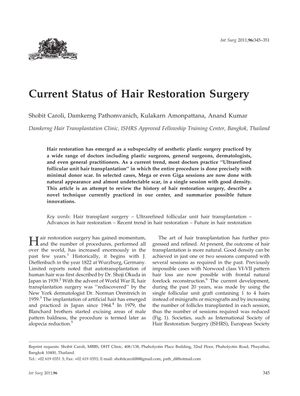Current Status of Hair Restoration Surgery
October 2011
in “
International Surgery
”

TLDR In 2011, hair restoration was a specialized field in plastic surgery, using techniques like "Ultrarefined follicular unit hair transplantation" to minimize scarring and promote hair growth, with future treatments like stem cell therapy and hair cloning still being tested.
In 2011, hair restoration had become a specialized area of aesthetic plastic surgery, with "Ultrarefined follicular unit hair transplantation" being the most common practice. This procedure, which minimized donor scar and could be done in a single session, used single follicular unit grafts containing 1 to 4 hairs. The strip technique and follicular unit extraction were the two methods used for graft harvesting. The trichophytic closure, introduced in 2005, resulted in minimal scarring. For class VI baldness, a minimum of two sessions was required. Medical treatment was also necessary to prevent further hair loss and promote hair growth in thinning areas. Future innovations like stem cell treatment and hair cloning were still experimental in 2011, with inconclusive results. Light therapy for hair loss was FDA-approved, but its efficacy was unproven in controlled studies. Artificial hair transplantation was not widely accepted and was banned by the FDA since 1982.



